New Mars Forums
You are not logged in.
- Topics: Active | Unanswered
Announcement
#376 Re: Meta New Mars » Housekeeping » 2024-10-04 17:31:54
This is the system that I described for solar concentrated with antifreeze heat exchanger embedded in the sand so that heat can be taken out later for heating.
#377 Re: Science, Technology, and Astronomy » Fluidized Sand Thermal Energy Storage » 2024-10-04 17:26:16
An image to go with words
heat exchanger imbedded in the sand
#378 Re: Interplanetary transportation » The Empire Strikes Back: ULA's Vulcan Rocket » 2024-10-03 19:08:14
Successful Vulcan launch early Friday would unlock lucrative future for ULA
Vulcan takes two BE-4 engines, which along with up to six solid rocket boosters provided by Northrop Grumman, give Vulcan more power than either Atlas V or the now retired Delta IV Heavy, with 3.6 million pounds of thrust on liftoff.
#380 Re: Unmanned probes » Official MSL / Curiosity Rover Thread | Aug 5, 2012 10:31 p.m. PT » 2024-10-03 18:59:14
#381 Re: Science, Technology, and Astronomy » Fluidized Sand Thermal Energy Storage » 2024-10-03 18:54:23
We have talked about sand but adding liquid now creates internal tank storage pressure. Sand battery was discussed in the Geothermal and Geothermal Battery (Changed Title 12/21/23) a Void started topic.
#382 Re: Meta New Mars » Housekeeping » 2024-09-27 18:34:53
Bought burial plots Monday which didn't include opening and closing which happened today. I am quite tired but I think she would have been happy. They didn't find out full term baby girl but moved her headstone next to her grave. Son from Texas got here late last night due to change in connector flight redirect. Spent time yesterday in the rain continuing the shed build with son that came down from Littleton.
#383 Re: Meta New Mars » Housekeeping » 2024-09-20 17:12:16
I have sad news to let all on the forum that know of my wife's conditions as she has passed today with her 3 sons that live still at home while I was away at work.
#384 Re: Science, Technology, and Astronomy » Vacuum plus Water Gravity plus Air Compression Energy Storage » 2024-09-18 19:20:06
Since working in units of meter is called for then the Ton is a metric ton or 1,000 kg which is 1,000 liters.
Storage is the units in a stagnant or none moving state.
The pipe sizes are also critical for the flow rates desired not only to maintain filling the tanks but for also pumping them to the top once more to close the loop.
Try to fill a 1-liter bottle in 1-sec. from the water facet and then you have a comparison point as that tap is at 40 to 50 psi. or https://www.aqua-calc.com/convert/press … -kilopasca https://calculatorpack.com/water-pressure-calculator/
Power turbin water exits out the bottom of the unit so its going to be mounted at the top of the down hill tank.
this shows the water re-entering the stream after exiting the pump
This is a turbine that one can build as a DYI if that is your choices.
Power generated would connect to a battery system and be draw out of it by the pump is we are unable to build a Ram pump.
otherwise, the battery then connects to the invertor to make 60 hz voltage for use.
#385 Re: Science, Technology, and Astronomy » Vacuum plus Water Gravity plus Air Compression Energy Storage » 2024-09-18 16:37:30
The storage is not a number but a variable that is determined based on the tank volumes, water amount, internal and external capability for pressure and vacuum as Caliban has already indicated due to implosion and explosion of the tanks and piping due to those levels.
So, you must decide on the level of work that must be produced to determine those values in the above statement. You must determine the power levels for the pump and generator in order to size all other aspects of a design storage and use.
One can make the storage the size of a walnut under extreme pressures or vacuum, or you can have a mountain size unit will be minimal of those.
The original numbers have already been given and they produce very little energy.
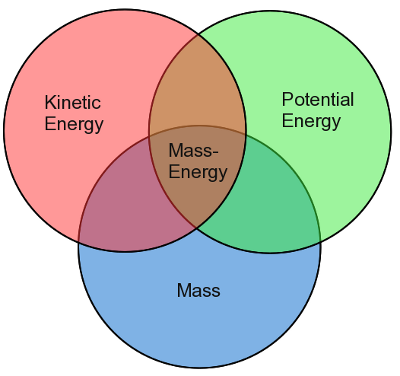
You must also include Gravity Energy Storage as they are part of the energy system by default.
We are still talking about the most efficient form of storage and conversion rate for Electricity, Work, and Power
Summary of Force, Work and Power
Force = Energy applied to an object(Measured in Newtons).
Work = Force X Distance, or the amount of heat transferred (Measured in Joules or calories).
Power = Work/Time (Measured in Watts)
Various Energy Units
1 calorie (thermochemical) = 4.184 J
1 Btu = 251.9958 calories
1 Btu (thermochemical) = 1054.35 J
1 kilowatt-hour (kWh) = 3.6 x 106 J
1 kilowatt-hour (kWh) = 3412 Btu (IT)
1 therm = 100,000 Btu
1 electron-volt = 1.6022 x 10-19 J

https://www.wikihow.com/Calculate-the-V … a-Cylinder
https://www.gigacalculator.com/calculat … ulator.php
https://en.wikipedia.org/wiki/Working_fluid
generator type for the working fluid determines inlet rate from the volume
This is also where we get into how much power wattage can I get for how long of a duration before refilling the volume.
Pressure control is achieved in hydraulic systems by metering the flow of a fluid into or out of a constrained volume to create force such as a jack for an automobile.
https://www.hi-force.com/en-uk/blog-det … te-a-force
https://www.hydraulicspneumatics.com/te … c-pressure
A pump adds energy to oil in any of the three ways, as described by Bernoulli’s equation:
Hydraulics pneumatics Com Sites Hydraulics pneumatics com Files Dec mc Eq1
where P is the pressure,
ρ is the density,
v is the velocity,
g is the acceleration due to gravity, and
h is the elevation.
More equations on the page
https://www.machinerylubrication.com/Re … re-vs-flow

Of course, this is moving the fluid to make pressure from the reservoir to the location to be moved.
Sensing functions that are computer controller-ed used to produce a response for more or less power seems to be good to have.
While I am thinking about gravity and water as the mass that we can make use of.
https://www.micro-hydro-power.com/water-turbines.htm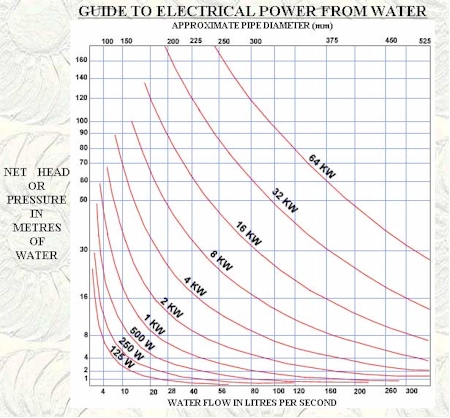
Power (watts) = Head (m) x Flow (litres/sec) x 9.81 (gravitational constant ‘g’) A typical water to wire efficiency is around 70%, so you should multiply the result by 0.7 to get the actual amount of electricity that you can expect from the site.
https://www.builditsolar.com/Projects/H … fRiver.htm
Power = (1/2)(Turbine Efficiency) (Water Density) (Turbine Flow Area) (Water Velocity)^3
Normally the mass is what will cause the turbine to move so knowing the amount and time is a flow rate.
Rotation is required and that is torque for the turbine.
Of course, when you need RPM's we are looking at that flow rate as it relates to the torque values.
https://www.studysmarter.us/explanation … al-motion/
https://en.wikipedia.org/wiki/Torque
Power in rotational systems (torque and frequency of a rotation)-527.png)
power generation from the top to the bottom means we want to make 2 -3 times what we would use. So I am looking at the 3kw turbine as it would cost less than $400 on ebay turbine
.



#386 Re: Science, Technology, and Astronomy » Vacuum plus Water Gravity plus Air Compression Energy Storage » 2024-09-17 18:16:06
Store of pressure or is defendant on size of chamber and period that measurement is done.
https://nooutage.com/hydroele.htm
https://attradev.ncat.org/wp-content/up … design.pdf
So off grid water power creators use an old washing machine motor rewound to producr 600 w at 24 v like this unit
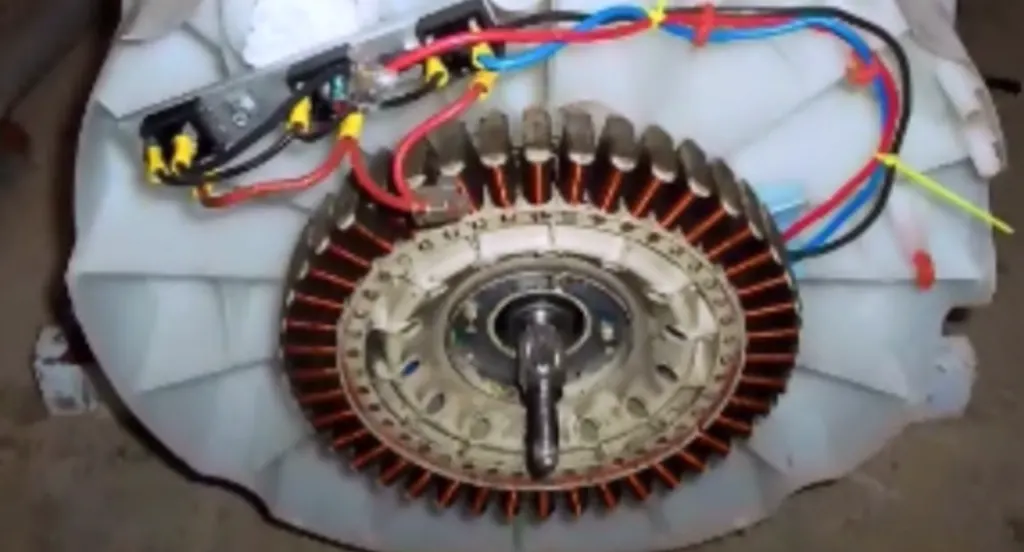
the magnetic disk that goes over the coils is not shown.
#387 Re: Science, Technology, and Astronomy » Vacuum plus Water Gravity plus Air Compression Energy Storage » 2024-09-15 17:55:57
In artesian well control design, a one-line jet pump or equivalent is used to move water from the non-pressurized water storage tank which is the bottom tank into a water pressure tank which is what we have with the top tank. It has a typical 20-40 or 30-50 psi trip point to turn on and off the jet pump that is in the well. Of course, that is an open loop system as we are closing the loop by creating energy with the released water that will travel down to the lower tank through a generator unit. While in a well we have 1 Atm above the well it's the column of water that build pressure to aid the pumping unit.
#388 Re: Home improvements » Solar Installation in McGregor, Texas August 2024 Start » 2024-09-15 14:35:00
Thats why storage batteries that are part of the power wall that KBD512 matter as excess since when you you want energy that is saved for later.
The frequency of 60 hz is looked at we are in the audio range and that makes the grid unit that GW has a part of an amplifier where the amplitude controls whether you are pushing energy into the grid.
#389 Re: Science, Technology, and Astronomy » Vacuum plus Water Gravity plus Air Compression Energy Storage » 2024-09-15 14:27:06
Starting with a tank that is empty will have in the space 1 Atm no matter how large the tank is. So, let's just fill a random size tank with 1 meter of water and only choose the height as the fixed dimension that matters. If we start at 2m tall and fill just 1-meter, the air pressure will rise to 2 Atm that the air occupies.
Now let's run the same experiment with a 3-meter-tall tank we have a result of 1.5 atm per meter that the air will occupy.
Ok we fill a 2-meter tank and vent the air we have zero pressure. But if we lower the level with 1 meter with the tank closed, we will have a -1 Atm in the void that is created after pumping it out. So now just assume that the tank is 3-meter tall and filled and we lower the level to just 1 meter then the void of 2 meters will have a -2 Atm.
#390 Re: Home improvements » Solar Installation in McGregor, Texas August 2024 Start » 2024-09-15 09:34:30
Thinking about when the storms take out the grid and the solar could produce power but is not due to missing AC sync field one could open the line and connect a sine wave invertor to that and while disconnected from the grid the home would be powered. Once can use a car battery and connected solar panels to the battery to charge it. without knowing the size of the AC field sync line, one might think that a 100-w unit would be capable of making the needed sinewave for the grid connected unit for home use while the sun is out. Since your design has no battery backup to it.
#391 Re: Home improvements » Home Solar System to Achieve Energy Usage Offset » 2024-09-15 09:30:01
Innovative company introduces new technology that automatically shelters solar panels: 'Stow early and stow often' as TerraTrak. It can protect the panels from one of the most damaging natural weather occurrences: hail.
Terrasmart's panels already feature PeakYield, a cloud-based tracker control and monitoring software, which allows the panels to move with the sun and avoid clouds to maximize their energy output.
Now, with the TerraTrak feature, the panels will be alerted when a storm is coming and move themselves to a 50- or 60-degree angle to protect themselves from hail or wind damage. The system is fully autonomous, meaning the panels will move without any human prompting, as Electrek detailed.
#392 Re: Science, Technology, and Astronomy » Vacuum plus Water Gravity plus Air Compression Energy Storage » 2024-09-14 18:18:45
update
1) water is 1,000 kg/m3 for water which is 1 metric ton.
2) power theoretically available (W) = 0 water flow as its not moving but if you use 1 m3/s rather than a 0
then it will be 9.81 m/s2 * 1 m3/s * 1,000 kg/m3 * 10 m = 98,000 w or 98 Kw/sec.
3) a vacuum is at the top means that water will not flow until the pump turns on to push the water out, for that energy is not present until a power source is used.
4) a vacuum at the bottom means that it will pull all of the tank until full / once air pressure in the top expands and drops as the water flows out. Which allows the turbine to turn and create power as long as the water is flowing. Power will drop as the water pressure drops as the top tank is emptied.
To get answers on the pump size and power we will need to convert units for the equations
https://www.engineeringtoolbox.com/unit … html#Power
We will need pipe diameters and a turbine generator to finish up a design.
so a minute means 98kw/s / 60 sec = 1,633 w/min and for the hour / 60 once more gets 27 w/hr which is quite tiny due to the quick flow rate. when we are looking for power in kilowatt we will need
Example - Energy in Elevated Water Volume
10 m3 volume of water is elevated 10 m above the turbine. The potential energy in the water volume can be calculated asW = (1000 kg/m3) (10 m3) (9.81 m/s2) (10 m)
= 981000 J (Ws)
= 981 kJ (kWs)
= 0.27 kWh
Due to 10 times more water to flow...
#393 Re: Science, Technology, and Astronomy » Vacuum plus Water Gravity plus Air Compression Energy Storage » 2024-09-14 14:13:27
Pressure is the compression as the water flows from the pumping of it to the top tank.
Just like vacuum is created from the pumping action but only if the flow from the top tank is stopped.
Otherwise, the pumping unchecked is aided by less resistance to water flow.
#394 Re: Science, Technology, and Astronomy » Vacuum plus Water Gravity plus Air Compression Energy Storage » 2024-09-14 14:08:13
Potential energy of the upper tank is mass x gravity and pressure
Energy created by the turbine as water flows to the lower tank is flow rate
Energy to be used via the homeowner kwhr
Energy used by the pump movement of water kwhr
#395 Re: Science, Technology, and Astronomy » Vacuum plus Water Gravity plus Air Compression Energy Storage » 2024-09-14 13:44:52
The tank at the top will have Compressed gas energy storage. as a result of pumping the water from the lowest tank to the top if the amount of water is greater than that of the volume in the bottom tank as the pressure will force the water back downward to the lower tank unless it's restricted until a max level of pressure is achieve. The shutting off of the water flowing only creates a minor vacuum in that tank as a result of the pumping of it.
The restriction of fluid flowing other than the turbine and valve is the size of the piping that is used which is contained in this topic Power Distribution by pipelines on Mars and others.
Water Flow based on Pipe Size Inside and Outside Diameters
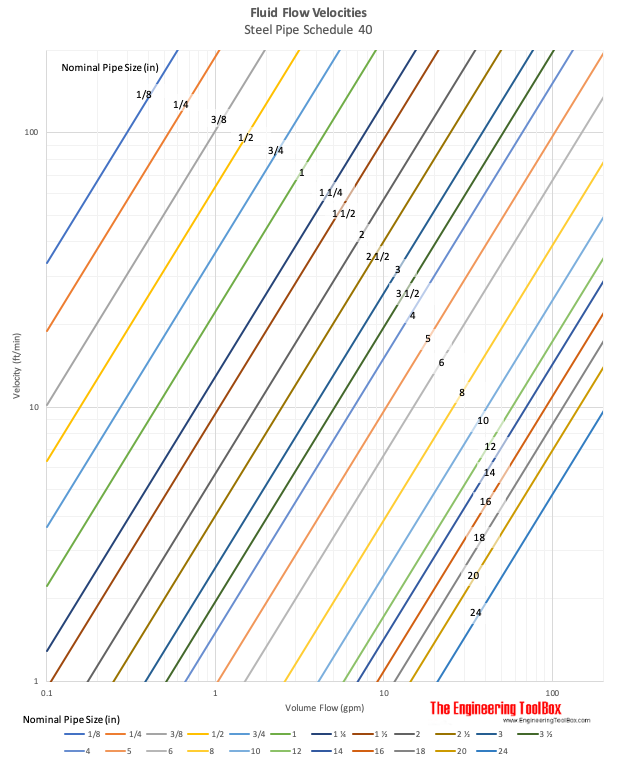
#396 Re: Science, Technology, and Astronomy » Vacuum plus Water Gravity plus Air Compression Energy Storage » 2024-09-14 07:46:04
water falling gives a level of generation as well
https://www.engineeringtoolbox.com/hydr … _1359.html
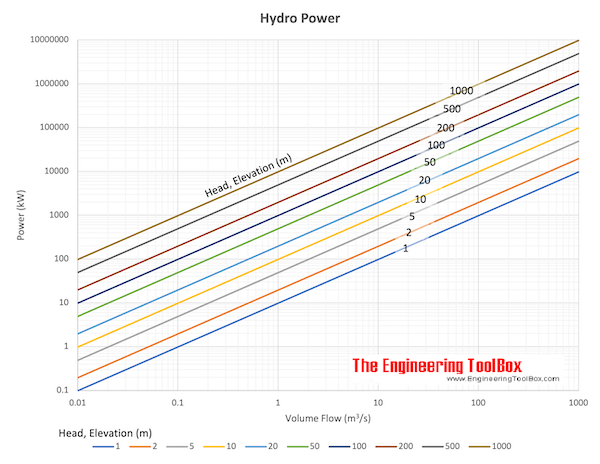
So we have both equations for up and down.
So the down equation - energy surplus must be still greater than the level required to pump it back up to the top tank.
The theoretically power available from falling water can be expressed as
Pth = ρ q g h
where
Pth = power theoretically available (W)
ρ = density (kg/m3) (~ 1000 kg/m3 for water)
q = water flow (m3/s)
g = acceleration of gravity (9.81 m/s2)
h = falling height, head (m)
#397 Re: Science, Technology, and Astronomy » CAES Compressed Air Energy Storage » 2024-09-14 07:31:06
Thats like the issue for gasoline engines as we only convert 25% of that potential energy due to equilibrium being 50%. So far only the solar thermal conversion is higher.
The energy equivalent of a gallon of gasoline is approximately 33.7 kWh or 1.213x10^8 joules. A gallon of gasoline contains the equivalent of 36 kWhs of electrical energy. Alternatively, a gallon of gasoline is equivalent in energy terms to 4 kilowatt hours
#398 Re: Science, Technology, and Astronomy » Oxygen bottleneck and fire ignition » 2024-09-13 17:20:16
related to earths oxygen What's the highest place on Earth that humans live?
Worldwide, more than 80 million people live at least 8,202 feet (2,500 meters) above sea level, mainly in South America, Central Asia and East Africa.
Some of the highest permanent settlements include Wenquan in China's Qinghai province, at a staggering 15,980 feet (4,870 m) above sea level, and Korzok in India, around 15,000 feet (4,572 m) above sea level.
However, one place towers above them all. Nestled in the Peruvian Andes is a town that is nicknamed "Devil's Paradise." Officially named La Rinconada, its 50,000 inhabitants live between 16,404 feet (5,000 m) and 17,388 feet (5,300 m) above sea level, making it the highest permanent settlement on Earth.
Like on Mars nothing will be easy.
#399 Re: Life on Mars » Covergent evolution Mars-Earth » 2024-09-13 17:16:29
All Life on Earth Comes From One Single Ancestor. And It's So Much Older Than We Thought.
A new study suggests that this organism likely lived on Earth only 400 million years after its formation.
The paper reads:
“The common ancestry of all extant cellular life is evidenced by the universal genetic code, machinery for protein synthesis, shared chirality of the almost-universal set of 20 amino acids and use of ATP as a common energy currency. As such, our understanding of LUCA impacts our understanding of the early evolution of life on Earth. Was LUCA a simple or complex organism? What kind of environment did it inhabit and when?”
“The evolutionary history of genes is complicated by their exchange between lineages,” University of Bristol’s Edmund Moody, the lead author of the study, said in a press statement. “We have to use complex evolutionary models to reconcile the evolutionary history of genes with the genealogy of species.”
Not satisfied with just learning its age, the team took things a step further and retraced the physiological characteristics of living species to understand what LUCA must’ve been like 4.2 billion years ago—and the results gave some surprising answers. The scientists estimate that while LUCA was a simple prokaryote, it likely had an immune system, meaning it was already fighting off primordial viruses.


